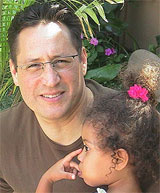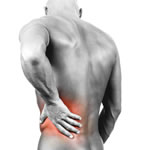
Bone Rattling News
Welcome to our monthly newsletter!
300 South Raymond Ave.
Ste. 19
Pasadena, Ca. 91105
(626)795-3456

John Bianchi
email - website
Exercise and Low Back Pain
Dr. David L. Phillips
[ read article ]
Pregnancy and Chiropractic, A winning Combination!
Dr. Jackie St. Cyr DC
[ read article ]
Infantile Colic Improved with Chiropractic
Dr. John Zimmerman
[ read article ]
How can I protect myself from sports injuries?
Dr. Pamela Stone
[ read article ]
Exercise and Low Back Pain
Dr. David L. Phillips
email - website
 Exercise has long been recognized as one of the keys to overcoming problems with the lower back. As a chiropractor, I regularly exhort my patients to exercise religiously. Mostly patients won’t exercise consistently no matter how simple and short your recommendations. When someone is in pain, the motivation is the highest and the resolution the strongest, but once the pain is gone so are the exercises. It seems to take several relapses to convince people that they must become proactive, and a partner in the process of healing.
Exercise has long been recognized as one of the keys to overcoming problems with the lower back. As a chiropractor, I regularly exhort my patients to exercise religiously. Mostly patients won’t exercise consistently no matter how simple and short your recommendations. When someone is in pain, the motivation is the highest and the resolution the strongest, but once the pain is gone so are the exercises. It seems to take several relapses to convince people that they must become proactive, and a partner in the process of healing. At first with most new patients I get the idea that they just want to dump their condition on my desk and they’ll pick it up in a few days, much like their dry-cleaning. The distinct impression is that they wish to remain passive, more an observer, albeit an unwilling one, to the healing of their own low back. So after a few episodes of trouble and after they have missed a few days work again, or another couple of rounds of golf, they get mad. Then one of 2 things happens. Either they quit coming, preferring to take drugs, or to go somewhere else and have that health professional convince them that they need to take their trouble seriously, or they begin to listen and act as a partner in the interest of their own health.
Over the last few years the emphasis in health care has been towards what is known as ‘evidence-based care’. In other words, if you can prove what you do works by randomized controlled tests and positive literature reviews, then what you do in health care will continue to get funding. Naturally as chiropractors we had to prove what we do six ways to Sunday before grudging approval was given, and then only if other therapists could be allowed to do it as well. Never mind how poorly trained or woefully inexperienced they were imitating us. Fundamentally what we do as chiropractors is adjust or manipulate/mobilize spinal joints, especially those of the lower back. And we do it very well, better than anyone.
Treatments that have been proven to work become part of a clinical guideline. Spinal manipulation and mobilization are now firmly imbedded in these evidence-based guidelines. However, once adjusted or manipulated, spinal joints then require rehabilitation. Rehabilitation of the spine can take on many forms: stretching, traction, electronic stimulation, heat and ice therapy, and on and on. But exercise is the cornerstone of skeletal healing.
As well as manipulation, all the recent clinical guidelines being promoted today for treatment of low back strains and sprains emphasize exercise, early and often. The concept of resting a sore lumbar spine is deeply entrenched both in the minds of the public as well as in medical circles and it is this notion that is frustrating the adoption of these new clinical guidelines. Study after study has shown that the recovery of one’s low back condition is absolutely inversely proportional to the time spent resting. “Get up and get moving” that is the new mantra for low back pain sufferers!
However, as good and as necessary as exercise is, it alone will not heal an ailing low back. A recent study in Europe proved this, again. This study was published in the journal Spine earlier this year (2003:28(6), pp. 525-532). What the authors did was take a group of 50 very chronic low back patients who had been off work from 2-6 months. These 50 people were divided into 2 groups. One received exercise only while the other group received manipulation and exercise. The exercise only group got sixteen 45-minute sessions over eight weeks. Patient improvement was measured before the exercise sessions began and at four weeks, six months and one year after the sessions ended.
Patients in the manual-therapy group received mobilization and what we call high-velocity, low-amplitude manipulation from trained medical people and physiotherapists. This form of treatment is exactly what chiropractors do and we call it adjusting the spine. Along with these manipulations this group also performed general exercises for the trunk, spine and legs.
Results? Guess what? Both groups showed significant improvements. However, the group that was adjusted experienced much greater improvements than the exercise group in all areas of improvement (pain, functional status, etc.) at every stage in the follow-up. The average reduction in pain was double for these lucky patients, compared to exercise patients. As well, when the study ended, the manual-therapy group was significantly more likely to have returned to work (67%, vs. 27% for the exercise group).
The biggest plus - and this really gets the attention of health insurance people - one year later, the exercise-only patients were over three times more likely to still be off work than the ones who actually had something done to them.
These results are spectacular even with the manipulations of ill-trained amateurs. That’s how powerful these spinal treatments can be. Imagine how much better the results would likely have been if actual spinal-specializing chiropractors had done the treatments!
Safe and natural chiropractic care for the entire family.